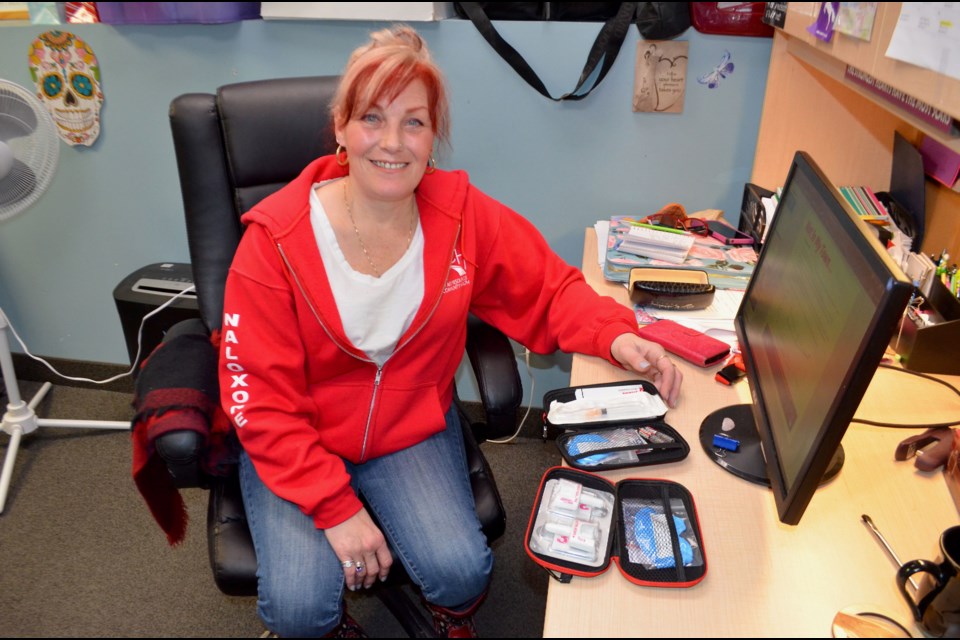It was Friday afternoon in the ARCH office at the Guelph Community Health Centre and overdose prevention coordinator Karen Lomax was busy inspecting a shipment of naloxone kits that just arrived.
“I do have the injectable kits but the ones I train with mostly are the nasal ones because they are so much easier to use,” said Lomax. “With this you are opening the package, tilting the head back, and spraying it up the nose and that’s essentially it.”
It sounds simple but the risk of dying from an overdose is still very high at that point.
“Naloxone is only buying you time to get 911 there because the opioids are still in your system swimming around,” said Lomax. “You have 30 to 90 minutes then it wears off.”
Naloxone is only effective for opiates so it won't help with someone overdosing on drugs such as cocaine or methamphetamines but if you suspect someone might be experiencing an opiate overdose it is better to err on the side of caution and administer the Naloxone than to wait and possibly risk their life.
“You are going to burn the crap out of their nose and they won’t be too happy about that but other than that you can’t hurt them,” said Lomax.
That short window of opportunity to get medical help could determine whether the overdose victim recovers completely, recovers with brain damage or dies.
Lomax teaches people how to recognise the symptoms of an opiate overdose and identify the different types of opiates available to drug users such as oxycontin, morphine, heroin and fentanyl. She also helps dispel a lot of the bad information people are getting about opioids.
“I do this work because we are dealing with an opioid crisis,” she said. “We handed out more than 1,300 Naloxone kits between January and November last year. For the presentations I go to different work spaces. Yesterday I went to a therapeutic horse farm where they work with folks with disabilities.”
Not all overdoses are caused by people abusing opiates.
“We do know that opioids are still being prescribed because for the most part they do work for pain,” said Lomax. “Someone could have taken an extra med by accident, which happens.”
Lomax was diagnosed with fibromyalgia in the mid 2000s and prescribed oxycontin to treat the chronic pain associated with the condition. She developed an addiction to the drug that led from one addiction to another.
“Addiction has been a part of my life on and off back since high school,” she said. “I had a very strange addiction pattern.”
She was born in Manchester, England, and moved to Canada when she was seven years old.
“We landed in Guelph because we had family here then we moved north and ended up back here when I was 13,” she said. “I have been here ever since, essentially.”
She used drugs socially during the 80s and 90.
“I danced with a bit of cocaine because that was the in thing in the early 90s,” she said. “I went on to have my babies and everything went away for a long time. I have always had a back problem and after birthing three babies I discovered I had this widespread pain.”
She was prescribed oxycontin for her pain but was cut off in 2008 when she exhibited symptoms of abuse and addiction.
“I had to go to the street to find it and back then there was lots of it around,” she said. “It just railroaded from there.”
She entered the methadone program to treat her opioid habit but that wasn’t the end of her addictive behaviour.
“If you get a copy of the methadone maintenance book it tells you it is a common trait to trade one addiction for another and I went to the crack,” she said. “That lasted for about three years. If it wasn’t for my mom I don’t know what would have happened to my three boys. She stepped in thank God.”
It was during that time that she got connected to ARCH and their harm reduction program.
“We hand out clean, new crack pipes, new needles and all of that stuff,” she said. “I always had a vehicle available to me so I would go to ARCH and pick up supplies for people.”
Her lived experience with addiction and her connections to street-level drug culture was seen as an asset by ARCH staff and they offered her a job as a peer support worker.
“Here’s me in full-blown addiction and I just got a job because of that,” she said. “I stumbled around for a year in peer support then I went to a thing for ARCH that was held in a church and this guy was talking about his mental health and the correlation between mental health and addiction. It was a Thursday and on the Tuesday of that week I bought my last piece of crack. I decided I’d had enough. I’m done.”
That was in 2011 and her life has been very different since then.
“I have always danced with mental health, depression and what have you,” she said. “I got back on my mental health meds and that’s how I’ve been able to quit. If you don’t have those mental health areas in check, how are you going to get your addiction in check? I am on those meds and vowed since then never to go off those meds and I haven’t and I have been sober since. If that’s what it takes then so be it.”
To learn more about overdose prevention, book a presentation or order a Naloxone kit contact Lomax at 519 994-5419 - [email protected] or 519 763-2255 #151
.png;w=120;h=80;mode=crop)

